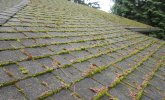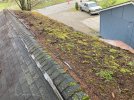Ryan Cash
Member
Do you need to brush moss on a roof? How do you remove moss from a shingle roof? Will SH kill roof moss?
I often see these questions pop up in groups and most of the times, the answers I see vary pretty wildly.
Usually the answer will come in some form of: “Treat moss with X% SH. The Moss will turn white and die but you need to let the customer know that it will take several weeks for the moss to completely detach from the roof and fall off with the weather.”
Most the time, people who are giving these answers aren’t dealing with roof moss on a regular basis. That process can work for small amounts of a certain type of moss but there are some areas of the country (specifically the Pacific North West), where that simply won’t work. Take for instance, moss accumulation like this:
I’ve cleaned thousands of roofs completely covered in moss and can say with certainty that simply blasting the moss with a hot SH mix will absolutely not solve the customer’s problem.
Most contractors will admit that it’s a pretty tough sell to tell a customer, “Your roof will look great in a few months, trust me!” While this may work for some customers with low amounts of moss, it’s definitely not ideal.
One other thing to note is that not all moss is created equal. Worldwide, there are over 22,000 types of moss. Additionally, roof moss is an issue that should be treated as soon as possible. Roof moss and lichen will not only damage roofs by eating away at the calcium carbonate in the limestone, but can also lift up edges of shingles, making them vulnerable to wind damage. Furthermore, moss can hold up to 20-30X it’s weight in water, causing pre-mature aging of the roof and a high potential for water intrusions.
Large clumpy moss will generally hold more water and is fairly easy to remove. Low lying, spindly moss can be almost impossible to knock down, as it’s more deeply rooted into the shingles.
So what is the process then? How can you remove moss from a customer’s roof safely without damaging the shingles?
The real answer is a little bit more nuanced than you might think. The first thing you need to understand is that the removal of moss like this will be labor intensive and will involve walking on the roof. I highly recommend this type of work only if you’re comfortable at heights and very familiar with fall protection set up and OSHA requirements.
With that said, Here’s what you need to know about moss removal.
First, dead and dried moss is infinitely easier to remove than living moss. The ideal time to remove moss from a roof is in the middle of the summer after a long period of no rain. The moss will be dried and brittle and can easily be dislodged.
Here is my recommended process of moss removal from a roof:
For areas in the country that are prone to moss growth, I recommend roof cleaning twice a year. Once in the fall to remove loose debris and leaves and then again in the spring time to apply a preventative chemical treatment to prevent moss growth.
While some may recommend solely using a soft wash approach to moss removal, I’ve found it’s only really effective in cases of minor moss growth. In my experience, moss will rarely completely detach and remove itself completely, regardless of how long it’s been dead.
On top of that, any moss that does die and detach will find itself in the gutter system and quickly block downspouts or work it’s way into any underground drainage system.
The reality of it all is that if you are careful and gentle, you can effectively make a moss covered roof look great the same day of service while not causing additional damage to the roof.
I often see these questions pop up in groups and most of the times, the answers I see vary pretty wildly.
Usually the answer will come in some form of: “Treat moss with X% SH. The Moss will turn white and die but you need to let the customer know that it will take several weeks for the moss to completely detach from the roof and fall off with the weather.”
Most the time, people who are giving these answers aren’t dealing with roof moss on a regular basis. That process can work for small amounts of a certain type of moss but there are some areas of the country (specifically the Pacific North West), where that simply won’t work. Take for instance, moss accumulation like this:
I’ve cleaned thousands of roofs completely covered in moss and can say with certainty that simply blasting the moss with a hot SH mix will absolutely not solve the customer’s problem.
Most contractors will admit that it’s a pretty tough sell to tell a customer, “Your roof will look great in a few months, trust me!” While this may work for some customers with low amounts of moss, it’s definitely not ideal.
One other thing to note is that not all moss is created equal. Worldwide, there are over 22,000 types of moss. Additionally, roof moss is an issue that should be treated as soon as possible. Roof moss and lichen will not only damage roofs by eating away at the calcium carbonate in the limestone, but can also lift up edges of shingles, making them vulnerable to wind damage. Furthermore, moss can hold up to 20-30X it’s weight in water, causing pre-mature aging of the roof and a high potential for water intrusions.
Large clumpy moss will generally hold more water and is fairly easy to remove. Low lying, spindly moss can be almost impossible to knock down, as it’s more deeply rooted into the shingles.
So what is the process then? How can you remove moss from a customer’s roof safely without damaging the shingles?
The real answer is a little bit more nuanced than you might think. The first thing you need to understand is that the removal of moss like this will be labor intensive and will involve walking on the roof. I highly recommend this type of work only if you’re comfortable at heights and very familiar with fall protection set up and OSHA requirements.
With that said, Here’s what you need to know about moss removal.
First, dead and dried moss is infinitely easier to remove than living moss. The ideal time to remove moss from a roof is in the middle of the summer after a long period of no rain. The moss will be dried and brittle and can easily be dislodged.
Here is my recommended process of moss removal from a roof:
- Pre-treat Moss with 5-6% Sodium Hypochlorite if Possible. Leave moss intact on the roof and leave. Return to the Customer’s home a week or so later on a dry/hot day when moss is dead and dry.
- This step is optional, but will make the removal process go so much better
- Using a strong, gas powered leaf blower, remove excess debris and loose moss from roof.
- Use a soft wire brush or broom to gently agitate the moss on the roof.
- The Goal is not complete removal of the moss, but rather about 80% removal.
- Aim to dislodge large clumps at base of shingles
- Using the leaf blower, blow off remainder of loose debris and moss from roof
- Clean the gutters!
- Post Treat roof with your normal roof wash to remove remaining stains and ensure that the remaining moss structure is dead.
- Treat roof with granulated Zinc Sulfate* or Sodium Diacetate** for preventative care of future moss growth.
*Zinc Sulfate is an excellent moss killer and preventative measure. It can be purchased as a powder but is most effective for roof cleaning in a granulated form. Rain water will cause the granules to release zinc onto the roof and will prevent regrowth of moss for up to a couple years.
**Sodium Diacetate is an “eco-friendly” alternative to the use of Zinc. It can be purchased in bulk as a heavy powder and is commonly used as a food additive to impart the “salt and vinegar” taste. For customers who live on water and are afraid of zinc run-off, it’s a great option!
For areas in the country that are prone to moss growth, I recommend roof cleaning twice a year. Once in the fall to remove loose debris and leaves and then again in the spring time to apply a preventative chemical treatment to prevent moss growth.
While some may recommend solely using a soft wash approach to moss removal, I’ve found it’s only really effective in cases of minor moss growth. In my experience, moss will rarely completely detach and remove itself completely, regardless of how long it’s been dead.
On top of that, any moss that does die and detach will find itself in the gutter system and quickly block downspouts or work it’s way into any underground drainage system.
The reality of it all is that if you are careful and gentle, you can effectively make a moss covered roof look great the same day of service while not causing additional damage to the roof.


